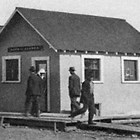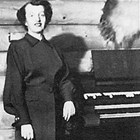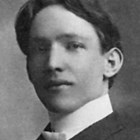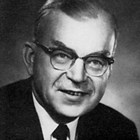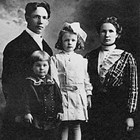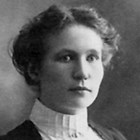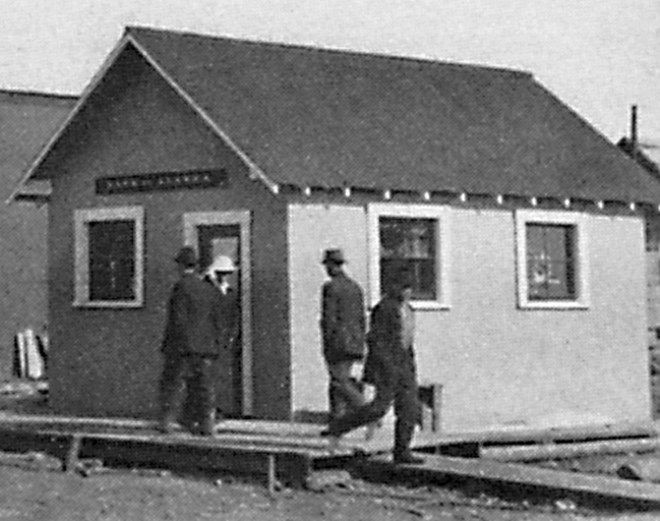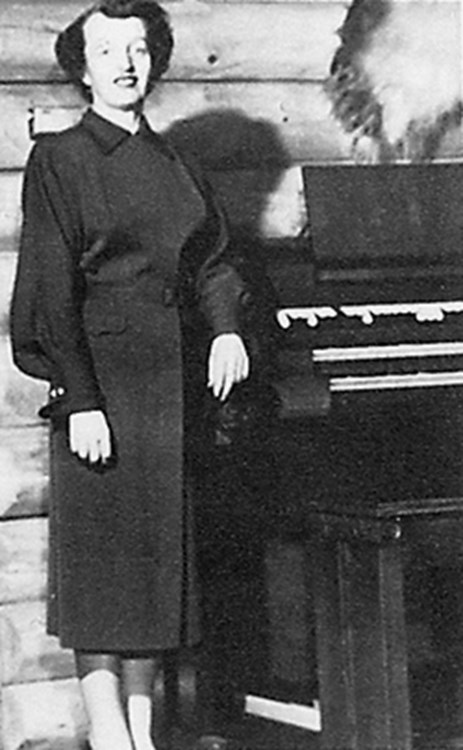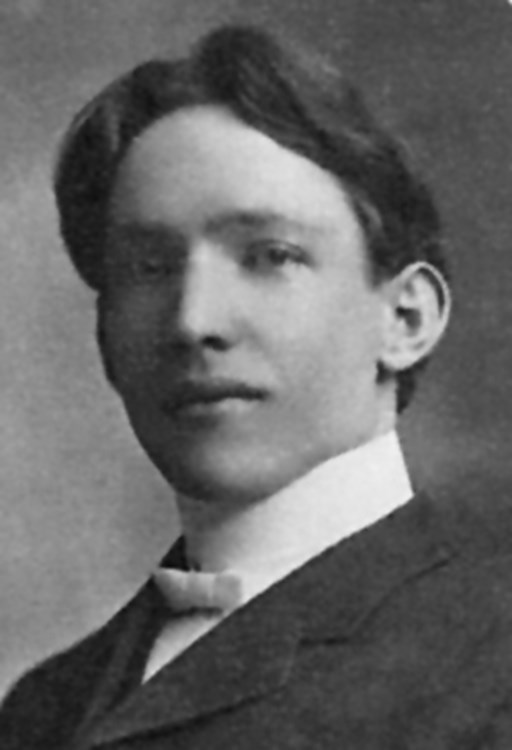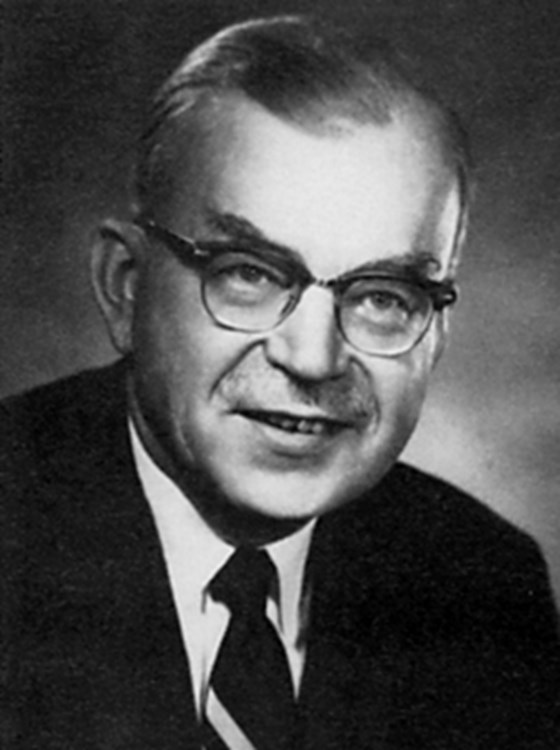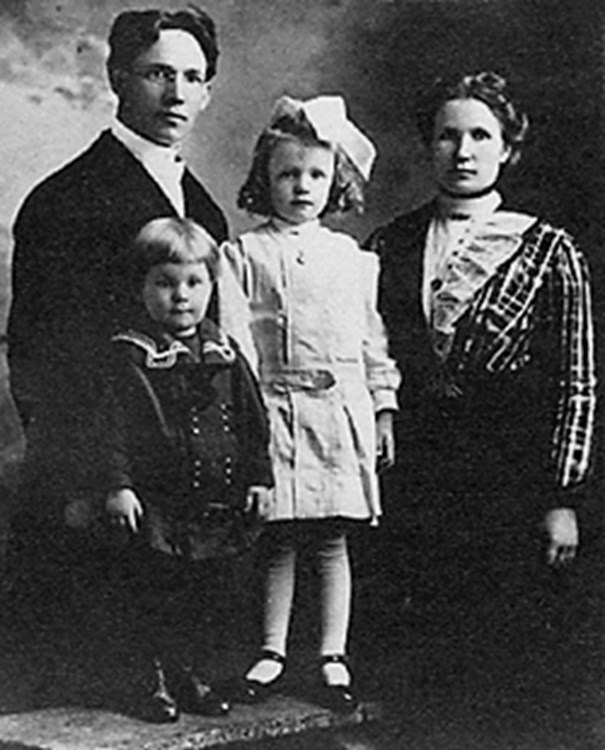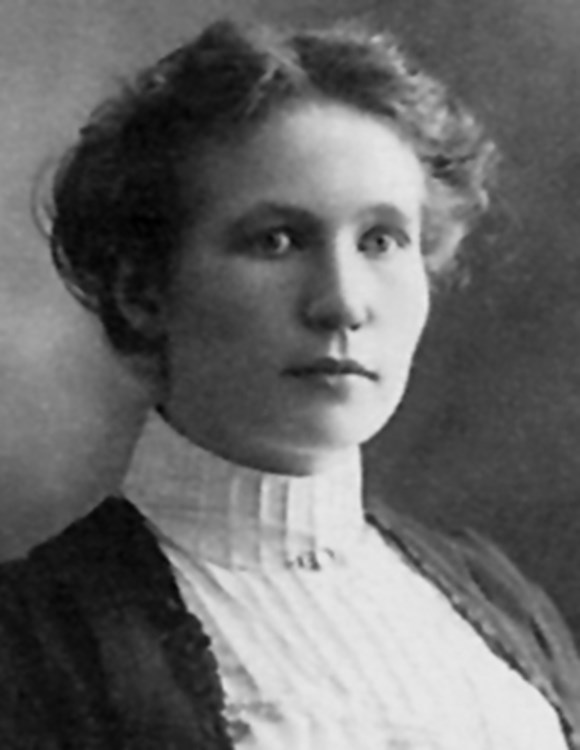Rasmuson, Edward Anton
1882-1949 | Swedish Covenant Missionary, Attorney, and Banker
Swedish immigrant Edward Anton Rasmuson arrived in Yakutat, Alaska, at the beginning of the twentieth century as a missionary and to teach in the school for Tlingit children. He married Jenny Olson in 1905 in Yakutat, where she also served as a missionary for the Swedish Evangelical Mission Covenant of America. In 1901, she arrived in Yakutat, at the age of twenty-one, to begin thirteen years of service to the Tlingit community of about 250 residents. They lived among the Tlingits at a time when their relative affluence could do little to protect the Tlingit from high disease and mortality rates following contact with Euro-Americans.[1] Their experiences as missionaries, social workers, and medical practitioners helped to develop competencies and confidence and accrue civic capabilities and social values that later supported Rasmuson’s advancement as a banker and civic leader and also instill a deep commitment for public service that would be instilled in their children. As noted by historian Mary F. Ehrlander in 2013: “That legacy today is embodied in the Rasmuson Foundation, by far Alaska’s largest and most influential philanthropic organization whose mission is to improve Alaskans’ quality of life.”[2]
Early Life
Edward Anton Rasmuson was one of ten children of Swedish parents, Sven (or Swan) Rasmuson and Hanna (Erickson) Rasmuson. He was born on April 5, 1882, while his parents were temporarily in Denmark. The Rasmusons lived on the family farm in Blekinge, in southern Sweden. In addition to his farm, Sven worked on the side as a carpenter and ran a cooperage shop in conjunction with the farm, producing a variety of wooden barrels and casks and containers for butter. Edward was raised on the family farm and completed his studies at a local school (equivalent to 9th or 10th grade). During vacation periods, he worked at various building trades, which proved to be valuable experience for later in life.[3]
Edward Rasmuson decided that there was no future for him on the family’s farm and, just prior to his nineteenth birthday in 1901, immigrated to the United States. On March 7, 1901, he departed as a steerage passenger from the port of Malmo to Liverpool and then continued to New York on the transatlantic ocean liner RMS Oceanic built for the White Star Line, arriving in New York fourteen days later. From New York, he left by train and settled in Minneapolis, Minnesota, and stayed with a friend who had recently arrived from Sweden. He was later followed by all of his siblings except for one sister who remained in Sweden. In 1924, his parents came to Minneapolis and spent their remaining years there.[4]
In the nineteenth and early twentieth centuries, Edward Rasmuson was part of a mass exodus of some 1.3 million Swedes to the United States. Sweden was fundamentally agricultural in nature, but strong population growth and crop failures increased the pressure on young and healthy men and women to move to North America for economic opportunities not available in the homeland. After the American Civil War ended in 1865, there were high peaks of Swedish immigration to the United States. After 1890, the pace of Swedish immigration remained high, and the U.S. Bureau of the Census recorded over 665,000 Swedish-born persons in the country, with an additional 700,000 persons classified as second-generation Swedish-Americans. Minnesota became the most Swedish of all of the states, with Swedish-Americans consisting of twelve percent of its population in 1910.[5]
In Minneapolis, Rasmuson attended the Skogsbergh School, founded by Swedish Covenant pastor Erik August Skogsbergh, later known as Minnehaha Academy. The Skogsbergh School was “a combination Bible institute, language center, elementary school, high school and business college with approximately 300 students, most of whom were Swedish immigrants or the children of Swedish immigrants.”[6] He studied higher mathematics, Latin, and Greek. He was then recommended by the Swedish Evangelical Covenant Church and hired by the U.S. Bureau of Education in 1904 as a combined school teacher and missionary at Yakutat.[7] In many small villages in Alaska, such as in Yakutat, the federal government never appropriated enough funds to build a public school. The government had relied on missionaries since 1885, under Presbyterian missionary and General Agent for Education in Alaska Sheldon Jackson, to provide teachers hired by the Alaska School Service of the U.S. Bureau of Education. [8]
Life as a Swedish Covenant Missionary and Teacher in Yakutat, Alaska (1904-1914)
In Yakutat, Edward Rasmuson shared preaching and missionary work with Covenant missionary Albin Johnson, while he also taught the Tlingit children in school. In Yakutat, he met Jenny Olson and they were married on April 28, 1905. She had been born in Skottkarn, Varmland, Sweden in 1880. She immigrated to Chicago, at the age of eighteen, to attend the Swedish Evangelical Covenant Church’s seminary there, North Park College. After her ordination as a pastor, in 1901 she was sent to the Covenant mission at Yakutat. Shortly after their marriage, Edward Rasmuson filed a declaration of intention in April 1905 to become an American citizen with the U.S. District Court in Juneau.[9] He became a naturalized U.S. citizen in 1910.[10]
In 1905, after Albin Johnson and his family returned to the Lower 48 states, Rasmuson was placed in charge of the mission and school. He served as a school teacher from 1904 to 1909, teaching the children eleven subjects, with emphasis on English language instruction for use in and outside school. Outside of the classroom, he tried to teach practical skills such as gardening, carpentry, and woodworking. The Rasmusons worked as the sole missionaries in Yakutat over the next decade, and also served as social workers and medical practitioners.[11] Edward Rasmuson also served as the U.S. postmaster at Yakutat.[12] There were two children, Maud Evangeline (born in Sitka on February 3, 1906) and Elmer (born in Yakutat on February 15, 1909).[13]
Edward and Jenny Rasmuson assisted in the health and medical needs of the Yakutat community. During this period in Alaska, missionaries and school teachers with limited medical training often served as the only western health care providers. In the late nineteenth century, Alaska Natives received little professional medical care, except occasionally from military doctors. Not having any medical training, the Rasmusons relied heavily upon a medical handbook (A Medical Handbook for Missionaries in Cold Climates, Philadelphia: Boericke and Tafel, 1904) written by the Moravian missionary, Dr. Joseph Romig, who was originally stationed in Bethel and later was a practicing physician in Anchorage. Since the nearest physician to Yakutat lived about 250 miles away in Sitka, the Rasmusons made daily medical visits to villagers’ homes, received hundreds of calls, and provided medical supplies from their own funds before the U.S. Bureau of Education sent provisions. Alaska governors repeatedly urged Congress to provide medical care for the Native population but there was little response. In 1908, the U.S. Bureau of Education finally contracted with three missionaries and two physicians to provide medical care to destitute Natives in the southcentral and southeast regions.[14]
In 1909, Rasmuson was relieved of his teaching duties due to his dual role as a missionary and teacher. This decision was part of a national trend to secularize education and to eliminate educational practices throughout the country where the federal government was perceived as creating unacceptable levels of support for missionary work. The U.S. Bureau of Education sent others to handle the teaching responsibilities.[15]
In 1910, Rasmuson was appointed as U.S. Commissioner in Yakutat, and served as the ex officio justice of the peace, magistrate, recorder, and probate judge. This appointment was in reaction to the challenge of alcohol abuse, which rose to higher levels after the operation of three canneries had led to sharply increased incomes in the village. For years, U.S. Revenue Service cutters had stopped at Yakutat on a regular basis to look for fur seal poachers, but made no stops to check on the welfare of the Natives. Finding legal work interesting, Rasmuson started to study the law by correspondence from LaSalle Extension University, rising at 4:00 a.m. to read before his work day started.[16]
Career in Law and Banking (1914-1949)
In September 1914, the Rasmusons left Yakutat and settled in Minneapolis. Years later, they reflected about their experience: “We both consider these years the happiest, most satisfactory and best remunerative years of our lives; would not have missed them for anything.”[17] The decision to leave the mission field was largely based on the realization that their children needed better schooling than was available in Yakutat. Rasmuson studied and was admitted to the bar in Minnesota. He invested his savings to purchase a block of homes, which he sold to finance his study of law.
In 1915, the Rasmusons moved to Juneau where Edward Rasmuson planned to practice law. After passing the Alaska bar exam and finding too many well established attorneys in Juneau, he accepted a position as U.S. commissioner and deputy clerk, U.S. District Court at Skagway. As the only attorney in Skagway, he served as legal counsel for the newly organized Bank of Alaska, the only branch bank in the territory with headquarters in Skagway. Less than two years later, the founder and first president of the Bank of Alaska, Andrew Stephenson, became ill, and Rasmuson was asked “to hold the fort” until another banker could be sent to Skagway. Rasmuson took a correspondence course to learn some of the technical knowledge of the banking business. After the departure of Stephenson, he accepted an offer to become the bank’s president after Henry D. Walbridge, the bank’s chairman of the board and largest stockholder, asked him to take over the failing institution. The bank’s vice president, Andrew Benton, a New York accountant, wrote Edward Rasmuson in 1918 of his confidence in him, stating that he was “one of the best men in the territory to have been associated with us.”[18] He knew virtually nothing about day-to-day bank operations and assumed control in July 1918 at probably the lowest point in the bank’s history, and other bankers believed it would close any day.[19] Rasmuson’s son, Elmer, later wrote:
“Without adequate training, confronted with huge loan and operating losses, made more difficult by a hostile regulatory and legislative environment, he turned the tide. It was only by his native ability, his resolute determination and above all, his unshakable confidence in Divine support strengthened by his missionary experiences.”[20]
Through long hours of patient study and diligent effort, Rasmuson was able to learn the banking business and rebuild the Bank of Alaska. From 1918 to 1944, Rasmuson served as president and director of the Bank of Alaska, after which he became chairman of the board. During this period, he transferred ownership of the bank from New York to Alaska mostly by purchasing stock. In 1946, the bank transferred its headquarters to Anchorage. In the same year, he transferred stock control in the Bank of Alaska to his son, Elmer.[21]
In addition to operating branches in Anchorage, Skagway, Cordova and Wrangell, Rasmuson established the First National Bank of Ketchikan. In the 1930s, the Cordova branch became independent and the Wrangell bank was separated from the Bank of Alaska. Elmer E. Rasmuson, became the third president of the Bank of Alaska upon his father's retirement in 1944.[22]
Rasmuson served as Swedish Vice Consul for Alaska for many years and was knighted by the King of Sweden in 1937. He was mayor of Skagway from 1921-1922. He also served as the Republican National Committeeman for Alaska from 1932 until his death. He was a member of the B.P.O. Elks, Pioneers of Alaska, and the Seattle Arctic Club. He was a Mason (32nd degree).[23]
Jenny Rasmuson was active in a number of civic organizations. She was president of the Skagway Woman’s Club, Presbyterian Women’s Association, and a past worthy matron of the Eastern Star. She was active in the Pioneers Auxiliary. She taught a class of teen-age girls in the Presbyterian Sunday School in Skagway for over thirty-five years. In the early 1950s, she moved to Anchorage to be close to her son, Elmer E. Rasmuson, and his family.[24]
Edward died on January 28, 1949 in Minneapolis, while he and Jenny Rasmuson were on a visit. He was buried at Lakewood Cemetery in Minneapolis.[25]
Legacy of Philanthropic Work in Alaska
In May 1955, Jenny Rasmuson created the Rasmuson Foundation to honor her late husband, Edward Anton Rasmuson. In accordance with both of their wishes, they left a portion of their estate “for the benefit of others.” The Declaration of Trust stated:
“The Rasmuson Foundation shall foster the advancement of the public welfare, the religious life, the public health and other charitable and public projects for the benefit of the people (of Alaska).”[26]
After Jenny Rasmuson’s death, the bulk of her estate, nearly $600,000, was transferred to the Rasmuson Foundation. Upon Elmer E. Rasmuson’s death in 2000, at the age of ninety-one, his vast personal fortune of more than $400 million was given to charity, much of it to the Rasmuson Foundation, making it the largest donor in Alaska.[27]
Jenny Rasmuson died on July 27, 1966, at Providence Hospital in Anchorage, due to a respiratory ailment.[28] She was buried in the Pioneer Tract of Anchorage Memorial Park Cemetery.
Endnotes
[1] See, Mary F. Ehrlander, “Edward Anton and Jenny Olson Rasmuson: Swedish Covenant Missionaries at Yakutat,” Alaska History 28, no. 1 (Spring 2013), 45.
[2] Ibid., 41.
[3] Terrence Cole and Elmer E. Rasmuson, Banking on Alaska: The Story of NBA, Volume I: A History of NBA (Anchorage: National Bank of Alaska, 2000), 93.
[4] Elmer E. Rasmuson, Banking on Alaska: The Story of the National Bank of Alaska, Volume II: Elmer’s Memoirs; Anecdotes and Vignettes of My 90 Years (Anchorage: National Bank of Alaska, 2000), 5.
[5] Swedish Immigration to North America, Swenson Swedish Immigration Research Center, Augustana College, Rock Island, Illinois, https://www.augustana.edu/general-information/swenson-center/academic-activities/swedish-american-immigration-history (accessed September 19, 2016).
[6] Terrence Cole and Elmer E. Rasmuson, Banking on Alaska: The Story of the National Bank of Alaska, Volume I: A History of NBA, 97.
[7] Mary F. Ehrlander, “Edward Anton and Jenny Olson Rasmuson: Swedish Covenant Missionaries at Yakutat,” Alaska History 28, no. 1 (Spring 2013), 46; and Elmer E. Rasmuson, Banking on Alaska: The Story of the National Bank of Alaska, Volume II: Elmer’s Memoirs; Anecdotes and Vignettes of My 90 Years, 6.
[8] See, Stephen W. Haycox, “Sheldon Jackson in Historical Perspective: Alaska Native Schools and Mission Contracts, 1885-1894,” Pacific Historian, 28, no. 1 (1982), 18-28, http://www.alaskool.org/native_ed/articles/s_haycox/sheldon_jackson.htm (accessed December 7, 2016); and Terrence Cole and Elmer E. Rasmuson, Banking on Alaska: The Story of the National Bank of Alaska, Volume I: A History of NBA, 102.
[9] See copy of declaration of intention, Edward Anton Rasmuson, July 15, 1905, U.S. District Court, First Division, Juneau, AK; reproduced in Terrence Cole and Elmer E. Rasmuson, Banking on Alaska: The Story of the National Bank of Alaska, Volume I: A History of NBA, 103.
[10] Edward Anton Rasmuson, Passport Application, May 3, 1922, National Archives Microfilm Publication M1490, Passport Applications, January 2, 1906 - March 31, 1925, Roll 1945, File: Certificates: 160726-161099, 03 May 1922-03 May 1922, U.S. Passport Applications, 1795-1925 [database on-line], http://ancestry.com (accessed December 7, 2016).
[11] Terrence Cole and Elmer E. Rasmuson, Banking on Alaska: The Story of the National Bank of Alaska, Volume I: A History of NBA, 104; and Mary F. Ehrlander, “Edward Anton and Jenny Olson Rasmuson: Swedish Covenant Missionaries at Yakutat,” Alaska History 28, no. 1 (Spring 2013), 41, 46, and 48.
[12] Edward A. Rasmuson, Yakutat, Alaska, National Archives Microfilm Publication M841, Record of Appointment of Postmasters, 1832-September 30, 1971, Roll 4, U.S, Appointments of Postmasters, 1832-1971 [database on-line], http://ancestry.com (accessed December 7, 2016).
[13] "Maud Evangeline was named for Queen Maud of Norway and for the heroine of the famous Longfellow poem; when she was older she preferred to be known by her middle name. Elmer Edwin was named for his father and Elmer Ellsworth Brown, the U.S. Commissioner of Education." Quoted from Terrence Cole and Elmer E. Rasmuson, Banking on Alaska: The Story of the National Bank of Alaska, Volume I: A History of NBA, 108.
[14] Mary F. Ehrlander, “Edward Anton and Jenny Olson Rasmuson: Swedish Covenant Missionaries at Yakutat,” Alaska History 28, no. 1 (Spring 2013), 44 and 50; and Elmer E. Rasmuson, Banking on Alaska: The Story of the National Bank of Alaska, Volume II: Elmer’s Memoirs; Anecdotes and Vignettes of My 90 Years, 9.
[15] Mary F. Ehrlander, “Edward Anton and Jenny Olson Rasmuson: Swedish Covenant Missionaries at Yakutat,” Alaska History 28, no. 1 (Spring 2013), 49.
[16] Mary F. Ehrlander, “Edward Anton and Jenny Olson Rasmuson: Swedish Covenant Missionaries at Yakutat,” Alaska History 28, no. 1 (Spring 2013), 52; and Elmer E. Rasmuson, Banking on Alaska: The Story of the National Bank of Alaska, Volume II: Elmer’s Memoirs; Anecdotes and Vignettes of My 90 Years, 10.
[17] Quoted in Mary F. Ehrlander, “Edward Anton and Jenny Olson Rasmuson: Swedish Covenant Missionaries at Yakutat,” Alaska History 28, no. 1 (Spring 2013), 54-55.
[18] Mary F. Ehrlander, “Edward Anton and Jenny Olson Rasmuson: Swedish Covenant Missionaries at Yakutat,” Alaska History 28, no. 1 (Spring 2013), 56.
[19] Terrence Cole and Elmer E. Rasmuson, Banking on Alaska: The Story of the National Bank of Alaska, Volume I: A History of NBA, 92.
[20] Elmer E. Rasmuson, Banking on Alaska: The Story of the National Bank of Alaska, Volume II: Elmer’s Memoirs; Anecdotes and Vignettes of My 90 Years, 15. See also, Mary F. Ehrlander, “Edward Anton and Jenny Olson Rasmuson: Swedish Covenant Missionaries at Yakutat,” Alaska History 28, no. 1 (Spring 2013), 56.
[21] Mary F. Ehrlander, “Edward Anton and Jenny Olson Rasmuson: Swedish Covenant Missionaries at Yakutat,” Alaska History 28, no. 1 (Spring 2013), 56; and Terrence Cole and Elmer E. Rasmuson, Banking on Alaska: The Story of the National Bank of Alaska, Volume I: A History of NBA, 92-93.
[22] “Edward A. Rasmuson Dies of Heart Attack,” Anchorage Daily Times, January 29, 1949, 1; and John P. Bagoy, Legends & Legacies, Anchorage, 1910-1935 (Anchorage: Publications Consultants, 2001), 165-166.
[23] “Edward A. Rasmuson Dies of Heart Attack,” Anchorage Daily Times, January 29, 1949, 1; and Tewkesbury’s Who’s Who in Alaska and Alaska Business Directory, 1947 (Juneau: Tewkesbury Publishers, 1947), 67.
[24] “Nominate Mrs. Rasmuson for Alaska Mother Honors,” Anchorage Daily Times, March 17, 1954, 11; “Jenny Rasmuson: 63-Year Alaska,” Anchorage Daily Times, July 28, 1966, 1-2; and Mary F. Ehrlander, “Edward Anton and Jenny Olson Rasmuson: Swedish Covenant Missionaries at Yakutat,” Alaska History 28, no. 1 (Spring 2013), 57.
[25] Edward Anton Rasmuson, U.S., Find a Grave Index, 1600s-Current [database on-line], http://ancestry.com (accessed December 7, 2016).
[26] Quoted in Mary F. Ehrlander, “Edward Anton and Jenny Olson Rasmuson: Swedish Covenant Missionaries at Yakutat,” Alaska History 28, no. 1 (Spring 2013), 57.
[27] Mary F. Ehrlander, “Edward Anton and Jenny Olson Rasmuson: Swedish Covenant Missionaries at Yakutat,” Alaska History 28, no. 1 (Spring 2013), 57; and Rasmuson Foundation, History, http://www.rasmuson.org/about/history (accessed December 7, 2016).
[28] “Jenny Rasmuson: 63-Year Alaska,” Anchorage Daily Times, July 28, 1966, 1-2.
Sources
This biographical sketch of Edward Anton Rasmuson is based on an essay which originally appeared in John Bagoy’s Legends & Legacies, Anchorage, 1910-1935 (Anchorage: Publications Consultants, 2001), 165-166. See also the Elmer Rasmuson file, Bagoy Family Pioneer Files (2004.11), Box 6, Atwood Resource Center, Anchorage Museum at Rasmuson Center, Anchorage, AK. Photographs courtesy of the Elmer E. Rasmuson Papers, Archives, University of Alaska Fairbanks, and the Rasmuson family. Edited by Mina Jacobs, 2012. Note: edited, revised, and expanded by Bruce Parham, December 7, 2016.
Preferred citation: Bruce Parham, “Rasmuson, Edward Anton,” Cook Inlet Historical Society, Legends & Legacies, Anchorage, 1910-1940, http://www.alaskahistory.org.
Major support for Legends & Legacies, Anchorage, 1910-1940, provided by: Anchorage Museum at Rasmuson Center, Atwood Foundation, Cook Inlet Historical Society, and the Rasmuson Foundation. This educational resource is provided by the Cook Inlet Historical Society, a 501 (c) (3) tax-exempt association. Contact us at the Cook Inlet Historical Society, by mail at Cook Inlet Historical Society, Anchorage Museum at Rasmuson Center, 625 C Street, Anchorage, AK 99501 or through the Cook Inlet Historical Society website, www.cookinlethistory.org.
